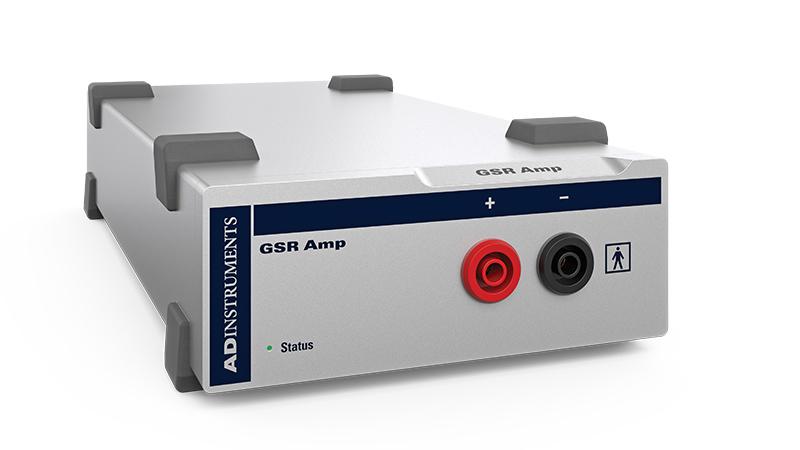
GSR Amp
Galvanic Skin Response (GSR) Amp
Overview
A fully isolated galvanic skin response (GSR) amplifier with low voltage, 75 Hz AC excitation and automatic zeroing. The GSR equipment is designed to work with a C Series Front End Interface or traditional PowerLab data acquisition system to measure human GSR, now known as electrodermal activity (EDA). The low-voltage AC excitation reduces the electrode polarization artifacts found in DC systems.
Included with the GSR Amp:
- GSR Finger Electrodes (Snap Lead)
- Velcro® straps suitable for adults
Accessories purchased separately:
Related
Research Applications
Key Features
- 75 Hz oscillator which supplies a near square wave, low-impedance, low-voltage (22 mVrms) signal to an electrode on one finger of the subject.
- Galvanic isolation for subject safety and approval to the IEC60601-1 standard for human connection as a body protected (BF rated) instrument.
- Automatic zeroing
- Supplied with GSR Finger Electrodes and adult Velcro® straps
Support
Support Articles
Our Support Articles contain answers to common questions, how-tos, solutions, and documentation.
Training and Workshops
Maximize time and resources with our customized training services delivered at your facility, on your equipment, on your terms.
Details and Tech Specs
Technical
Input
- Connection type: 2 × 4 mm (0.16") shrouded banana plugs to custom cable. Two dry, bright-plated, bipolar electrodes with Velcro™ attachment strap suitable for adult fingers.
- Excitation: Constant-voltage AC excitation (22 mVrms @75 Hz)
- Current density: ≤0.5 μA cm–2
- Safety: Approved to IEC60601-1 BF (body protection) standard
- Input isolation: Transformer isolation (AC bridge operation)
- Isolation rating: 4000 V ACrms for 1 minute
- Amplification ranges: 1 to 40 μS full scale in 6 steps (combined PowerLab and GSR Amp)
0 to 20 μS
0 to 10 μS
0 to 4 μS
0 to 2 μS
0 to 1 μS
- Frequency response: –3 dB at 1 Hz
- Accuracy: ±5 %
- Input leakage current: <3 μArms at 240V, 50 Hz <2 μArms at 120V, 60 Hz
- Zeroing and offset: Automatic software-controlled fast zeroing, controlled by internal 12-bit DAC; resolution = ±0.2 μS
Output
- Analog signal: ±2 V full scale
Control Port
- I2C port: Provides control and power. Interface communications rate of ~50 Kbits/s.
Physical Configuration
- Dimensions (h × w × d): 55 mm × 120 mm × 260 mm (2.2" × 4.7" × 10.2")
- Weight:1.2 kg (1 lb 10.5 oz)
- Power requirements: 2.5 W maximum
- Operating temperature range: 5 to 35 °C, 0 to 90% humidity (noncondensing)
ADInstruments reserves the right to alter these specifications at any time.
Product Code
Compatibility
FE116
| Operating System | Recommended Hardware | Alternate Hardware | |
|---|---|---|---|
| LabChart Lightning | Windows / Mac | PowerLab C + Front End Interface | Traditional PowerLab |
| LabChart 8 | Windows / Mac | PowerLab C + Front End Interface | Traditional PowerLab |



